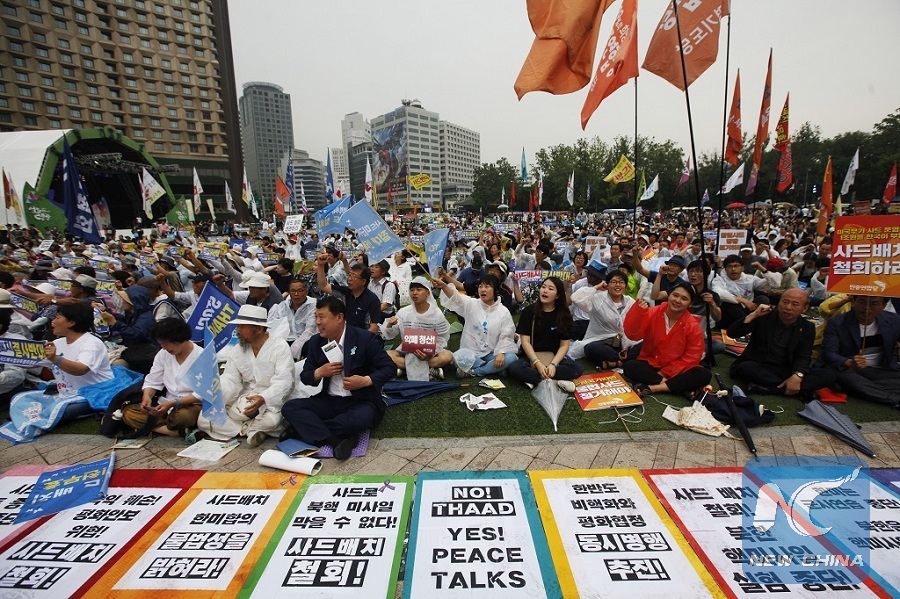
Demonstrators attend a protest against the deployment of THAAD in Seoul, South Korea, on June 24, 2017. (Xinhua/Yao Qilin)
SEOUL, July 29 (Xinhua) -- Voices were raised Saturday to oppose South Korean President Moon Jae-in's decision to deploy four more mobile launchers of the U.S. Terminal High Altitude Area Defense (THAAD) missile defense system in the country's southeast region.
President Moon ordered his aides during an emergency national security council (NSC) meeting to consult with the U.S. side on the installation of the remaining THAAD launchers in response to the Democratic People's Republic of Korea (DPRK)'s test-launch of a ballistic missile.
The DPRK announced another successful test-firing of what it called an intercontinental ballistic missile (ICBM) that flew about 1,000 km and was lofted as high as around 3,700 km. It was an advanced Hwasong-14, which traveled 933 km at a maximum altitude of 2,802 km at the July 4 launch.
The show of force and the deployment of four more THAAD launchers "never become a way to resolve" the DPRK's missile threats, the People's Solidarity for Participatory Democracy (PSPD), a local liberal advocacy group, said in a statement.
The South Korean president ordered the joint missile live-fire exercises with the U.S. military, which were conducted early in the morning along the South Korean east coast.
It was reconfirmed, the statement said, that the show of force and stronger sanctions failed in the past to discourage the DPRK from developing its ballistic missile technology.
The statement said the strengthened South Korean missile defense capability through the U.S. missile shield cannot resolve the DPRK's ICBM threat, demanding the cancellation of the additional THAAD installation decision.
The DPRK's ICBM is not a direct threat to the South Korean territory, which borders the DPRK, as an ICBM has a range of at least 5,500 km.
THAAD is designed to shoot down incoming missiles at an altitude of 40-150 km. DPRK missiles targeting the South Korean territory are known to fly at an altitude of less than 40 km.
The THAAD deployment site is located in Seongju county, North Gyeongsang province, about 300 km southeast of the capital Seoul. The U.S. missile defense system is incapable of protecting the capital city and its suburban areas, which have about half of the country's 50 million population, from possible missile attacks of the DPRK.
The minor progressive Justice Party said in a statement that the THAAD's operational effectiveness has not yet been validated, calling for the government to take a cautious approach to the additional THAAD deployment.
On April 26, two THAAD mobile launchers and other elements were transported in the middle of night to a former golf course in Seongju county.
Four more THAAD launchers were reportedly delivered to a U.S. military base near the county. One THAAD battery is composed of six mobile launchers, 48 interceptors, the AN/TPY-2 radar and the fire and control unit.
Residents in Seongju and Gimcheon city, which borders the county and directly faces the super microwave- emitting radar, have continued anti-THAAD rally every night since Seoul and Washington announced the deployment decision in July last year.
The PSPD statement said the military option such as the show of force and the additional THAAD installation, which South Korea unveiled, would only boost arms race in Northeast Asia and worsen relations with neighboring countries.
Neighboring countries, including China and Russia, have strongly opposed the THAAD in South Korea as its X-band radar can peer deep into the territories of the two countries, breaking the regional strategic balance and damaging security interests of the two nations.

